ABANYALA BA KAKAMEGA: Indigenous Games and Sports.
Abanyala ba Kakamega have various sports and games for children and men in the society. Elderly women only play a role of teaching children the games.
The following were the major games.
The following were the major games.
- Amakhu- These were fights involving cattle- specifically bulls. The game spontaneously took place at the grazing fields where people enjoyed by cheering and jeering. At times, herdsmen could goad the bulls from one herd to fight with another bull from another herd. This was done after grazing and ignited by forcing the bulls to smell blood from a tick. No specific organised days and events were reserved for amakhu among Abanyala ba Kakamega. It was just a grazing field event. Also, the children had soil made animal-toys that they played with imitating the animal fights in a game that they too called amakhu.
- Amakoora- game played by young girls and young boys. The players sit in a circle around a hole on ground filled with 20 to 30 small stones or marbles. The first player picks up one of the stones and throws it up in the air, collects one pebble from hole then catches the descending marble. She progressed on as she returns it and pick two following the same procedure. This goes on to three, four and so on until all pebbles are collected at once. The second round of the game involves throwing up all the pebbles into the air and trying to collect them with the back of her palm or palms placed together. Once all players have had a chance, the stones are counted and the one who collects the most is the winner.
- Amarende- game of spinning prepared seed shells from a tree called omurende. The seed had the poles opened, the seeds removed and an axis stick inserted in the holes. A hole small hole was made on the belly of the fruit shell to produce sound as the seed spins. To set it off, string was wound on one of the protruding pole sticks and held by index finger against a hollow stick into which the string was attached to a peg. The peg was pulled to release the spinning seed into motion in air before being left to land on the ground. The owner of the seed that was left spinning after others have stopped became the winner.
- Amawi- there were special organized wrestling games for the men in the society. They were accompanied by singing and dancing omutindi. Two teams participated in this game; either team proposed their strongest man to face an opponent. A council of elders was chosen as a referees. The players started by facing each other, bringing the right palms of their hands into contact as in a hand shake and then trying to bring down each other using their hands and feet. No kicks, knee hits, fists or head butts were allowed. There were specific arenas for wrestling games. Among that last known players of amawi from East Bunyala was Makokha Wekhuchu from Mayuke and Mulati from Lutaso. Winners of amawi were declared the de-facto leaders of warrior group or abasiyenga (body guards to leaders)
- Anjika- dancing of puppets. The puppets were usually tied of the legs and played when sitting while singing.
- Apusyu- it was a pact game involving snatching of an item from the hand of one who has it but is not keen. The pact had it that the item becomes the property of the one who snatched- after snatching.
- Chanja makulu- a game that involved stepping on the shadow of your playmate. One had to run away or go to a shade.
- Chilumbe Ngololiro- game by children as they attempt to teach each other the various dance styles of Chilumbe dance. They made a circle and one is pushed in at a time to demonstrate a dance to the rest.
- Ebicharachara- game of running around with rotating wind vane made from leaves of bananas, maize, nappier grass or sugarcane.
- Ebikuli- This was a game involving he-goats or male sheep fighting. At times, children coaxed them to fight at they enjoyed.
- Ekomangoma- a game of running around rolling items on wheels. Due to modern cars, the early wheels called ekomakoma was replaced with wire made wheels in semblance to vehicles.
- Epuuki- these were organized night dances involving mature boys and girls after specific ceremonies.

Epuuki - Embuumi- children made a wheel from bones or soil and put a string through two hole in it. They made the wheel to turn as they enjoyed the sound. At times, two spinning wheels could be knocked together and one which stops is said to have lost.
- Eminaye- riddling games. Usually done in the evening.
- Emuli- there were varieties of games involving use of grass reeds.
- Endika- a game by boys that involved rolling a ringed stick to follow designated path marked with pegs. One had a string and stick that helped to propel it while the other had a forked stick. After the advent of tyres, it was made from tyre cut and bicycle rim.
- Endolio- game by children that involved hitting marbles, sizable fruit seeds or pegs into a hole. It involved hitting the opponent's marble into a hole by fingers or by sticks. When played with sticks, the seeds or pegs were hit the way a hockey ball is hit but aimed at hitting the opponents' ball into a hole called efubo ya endolio.
- Engarangarani- waist ring game played by girls. They made a ring from stick to revolve around their waist as they sang "Khatungutie mwana wefe khatungutie- karangarani." The winner was one who could swing it up and down the body in many revolution.
- Engero- it was a game involving completion of proverbs. One who gives answers to more proverbs became the winner. Usually played in presence of elders.
- Engacho- these were competition involving telling of jokes. They were the traditional stand up comedian. They were of various types at times involving learning sarcastic statements similar to mchongoano of Kiswahili. Whoever elicited more laughter by giving a new joke became the winner. Similar to kiswahili michongoano and vichekesho.
- Engwe kolongolo- This was a rain dance by children. It only took place a time when it was raining and the the sun was shining at the same time. Children skipped around claiming it was a sign that the leopard has given birth. It was a dance danced in the rain.
- Enungo nende oulalo- children stood in two rows facing each other and held their hands. Another child could lie across the hand to be tossed from one end to the other.
- Esabaa- it was a game that trained target hitting. The play item could be stones, arrows, spears, sticks or fruit seeds. A target was selected and attempts to hit the target by players made. Whoever hit the target many times became the winner.
- Esifundo- football with ball made of leaves, animal badder or papers.
- Esikhu- it was a young boys' boxing game. Two boys of same age could be coaxed to fight under watch of their peers. The fight had specific rules on where to hit. Unfortunately, such games ended with cries and injuries.
- Esimbi- tossing of four shells or maize seeds with plumule area removed to create head and tails. They were thrown on ground and patterns of tails and heads observed to declare a winner of a point. At times, it was played as a form of gambling.
- Esipula also called esicholo or esicholonjio- it was a game for young girls and boys. They drew a triangular pattern on the playground. An object, usually a piece of wood (esipula) or broken piece of pot (esikolonjio) is thrown by a of player, through patterns of squares outlined on the ground followed by hopping through spaces with one leg as you pick the thrown item. At times, two opponents played at the same time each starting from either end.
- Esitoloolo- game played by boys. A small piece of timber was tied on a string and swung round in air as it produced zooming sound. Whoever zoomed it for long became the winner.
- Etiololo- a game of making a pyramid-shaped peg to rotate on the ground. Big pegs were made to rotate by help of a string tied on a stick. The winner was he whose peg rotated for long. Small pegs or conical seeds could also be set into spinning on a flat surface by use of the thumb and index finger.
- Emburuusi- game of playing by using slings to hit a target. The game involved knotting one end of a string with a circular ring in its middle around one’s digit finger leaving the other end free. The stone was placed at the curricular ring at the center of the rope. The free end of the rope was held together with the tied end, enabling a stone to be held in place. Playing involved the action of a performer rotating the arm bearing the sling and stone until the attainment of the necessary velocity. The player then let loose the free end of the rope which in turn released the stone to a target direction. Whoever hit the target became the winner.
- Emibaso- it was a game of trapping birds and moles using snapping sticks. One who got more in his traps was the winner.
- Emitati- game of shooting arrows to a set target. The target was usually made of banana stem or a ball of clay hung on a branch. The game trained warriors on hunting and defense skills.
- Esicharachara- it involved making a rotating vane from maize leaves which rotated on a thorn handle as the child ran around with it.
- Kafumbo- Evening game for both boys and girls. It involved light patting someone on the back, shouting kafumbo (bye) and taking off. The patted participant had to revenge the kafumbo to another member of the opponent group. Each player tried to dodge the pat.
- Khunyanye ou! This was a game that was occasioned by an accidental fart. It was meant to help know whoever farted secretly in case nobody was taking responsibility. One child started to sing: "Khutekhe amayenge, ou; nundi khunyanye ou." The others joined in, rubbed the palm of on right fist as they hit at intervals. Whoever hit when the leader stops abruptly or does not hit when the leader was still singing was believed to be the one who released the silent fart.
- Kurusumee- game by little children. They sat in a circle or a row, stretched their legs in front of them close to each other and one of then touched the legs as he or she said 'Kurusumee," before bursting into a song. The singer continued touching the feet up to the last person at end of the song. That last person folded the leg.
- Marobo tandarobo- game of moving stones or marbles around. It a game at the start of formal education which was a corruption of "The marbles, turn the marbles."
- Muturusia or kachi (kati)- it was a game of dodging the ball. Three players participated at a time. Two throwing the ball aiming the hitting the one in the middle. One in the middle attempts to dodge or catch the ball. Winner was one who dodged many throws and caught many throws.
- Mushuuta- kind of football involving two groups shooting against each other to score without physical tackle. After blocking the ball, it was not supposed to touch the ground. Winner was one who scored more goals.
- Namukhorondo- a children's game of throwing wet soil lump using a stick to a target place. The soil was attached to the stick end and the stick swung in air to release the soil lump.
- Namundolio (Namulolo)- it was a game of learning to hit away an item thrown at you using a wooden log. One group on one side called out 'Namundolio' and the other one prepared by saying 'kwiche'. The item was them thrown which was deflected in a style similar to playing cricket.
- Nalufulyungu- hide and seek game.
- Nalukhasikhasi- a collection of game of hide and seek played by the children. There were varieties of nalukhasikhasi games but all of them involved playing family roles.
- Nasio- a game by children aping the grinding of grain on grinding stone as they sing. They sang: "Owule wange, Owule."
- Ngoroti kongolo- human formed a chain by players holding each other at the waists and moving around in zigzag way as you sing 'Njira okhu, Ngoroti." At the end, the leaders of the two teams locked hand and pulled the other with an aim of breaking of a member from the other group. The person or persons so captured became a prisoner only to be exchanged with another team's capture. Winning team is one that had many captives.
- Okhuchundula etwesi- a game of aiming at and hitting the centre space of a rolling hoop using a spear or stones. Those who hit the centre or made the thing thrown to go through the centre qualified for next round until one winner remained.
- Okhukhupa amakata- this was a game by uncircumcised boys. They played in imitation of circumcision song using 'jingles' made from maize stalks. It was only played during circumcision year.
- Okhutiringisa- a game involving balancing a stick vertically on a finger, palm or back of hand. Whoever balanced it for long became the winner.
- Okhutupa emitunga- game by men and strong boys. Done in an open field that could accommodate a throwing event. The main equipment used were emitunga (spears without iron heads) and evichangi (pegs). After a throw of omutunga, the distance was marked using a esichangi for each of the participant. The winning individual was determined by the longest throw achieved towards a target location.
- Okhwetemba- this involved any drama plays. Some involved use of masks. Basically used in teaching social roles and activities such as wrestling, tieing for purpose of slaughtering animals etc.
- Okhwetungeresa- a game of balancing items such as firewood, tray or basket on head the for girls.
- Olukho- Game by men and boys. Wooden trough with eight rows of holes on either side into which seeds were place. The olukho had two store holes on either end. Small stones or seeds were used in earlier days; today, using marbles is common. The player aim to move his stones around so that you can capture more than your opponent. It’s fun, but strategic, much like chess.
- Olukaka lwatinya- a game by children. They form a circle and hold hands. One of them is put inside and attempt to break through the weaker area as he or she is blocked by the others. It was accompanied by singing 'Olukaka lwatinya, Khusichiranga musala si, khusichiranga omusangula"
- Okhusuliana- mock fight using stick and shield. A hand held stick spear was brandished around or lightly thrown at opponent. The opponent had to block it using a shield make from skin. Whoever blocks many attempts aimed at him became the winner.
- Olusia- The game of the string played mainly by girls. This game starts with a string from the ankle, being raised all the way up to the neck. A skipping string called olusia is made by joining the two ends. Two players stand on each end of the string, raising it inch by inch as the other attempts to jump into the string. At time two players can jump in. Aimed at jumping in successfully.
- Okhuloba- at times, fishing was done as a competition among boy. Whoever got more fish within a specified period became the winner.
- Okhulonda olwikho- it was usually a family game that involved reciting names of specified relatives. For example one could be asked to name all the sister to their grandfathers and their respective children in the order of birth.
- Okhusoka- swimming game done by youth in rivers. Swimming and life saving skills were taught. Swimming took place at non dangerous places of the rivers. There were various competitions under swimming: diving (okhukhupa olutumbi), submerging in water as others count, (okhweyinikha), going against the flow current and showcasing floating styles.
- Okhwesuba- children game of swinging. It was made by one who ties a rope on a branch of a tree on which a seat stick attached attached the end. Also, boys played it using climbers in the forest.
- Okhwechingicha- skipping a rope which one is holding by both ends. At times, it involved two people skipping one rope as a team. There were different patterns of swinging the rope.
- Okhwekhuluba- it involved blocking a stream of water then breaking it as you enjoy being swept away by the water.
- Okhwesungwacha (eyika)- sea-saw game played on logs and poles.
- Olubimbi or esikhoo- A game played on a board with circle or square board with lines drawn on it. It involved moving the beads to ensure ones beads are on a straight line through the center or to make your opponent have no place to move. Most children drew it on their desks upon joining school.
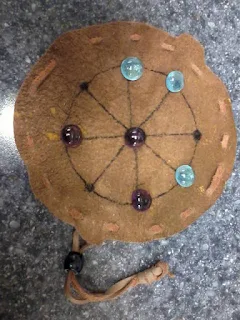
Olubimbi - Olubimbi lwa Keya (eturafu)- This is the game of checkers. It was a modification of olubimbi introduced by returnees from (Keya) KAR.

Olubimbi lwa Keya (eturafu) - Olukakelelwa- a game played by swinging on tree branches in a forest. At times it involved competing in climbing trees, tying ropes swinging from one tree branch to the next within a forest for a distance without coming on ground. It was because of this game that Abanyala were called abakakilelwa for they jumped from tree to tree like monkeys.
- Okhukhwesa omukoye- tug of war involving pulling of a rope made from skin. This was one of the main games by men although children of both sexes took a go at it.
- Okhuyima- hunting game perfected by hunters.
- Olumbuchu- it was a whirling game by boys and girls done in an open field. The players whirled individually round and round until they lost control and one by one fell to the ground. The last player to remain whirling was declared a champion.
- Omukhwesero- This was a social game than involving one enjoying a ride on an item such as a log, branch or v-shaped branch by being pulled by others.
- Omutiembekho Mumbo- it involved boys competing in walking while perched on two wooden rails called emitunga. It was a balancing act. It times it involved players masking themselves using climbers or leaves or woven masks or curved masks.
- Omwiswerere- sliding game done on a slippery slope by young boys. The surface had a path made by removing grass then made slippery using cow-dung, wet clay soil and water. A seat called epongi was made from a banana stalk or log of curved Nandi frame tree was used. Two sticks measuring about half a metre long each were pushed though the seat at back for handles and front for leg rest. Sliding seats made of banana stems or logs used to move the players downhill.

Omwiswerere - Owukotio- this involved any acrobatic moves that formed part of entertainment.
- Papulikani- a game of skipping a rope done mainly by young girls. It involves swinging a rope in a circle motion often while singing a song "public van, public van' hence the name pupulikani. When swinging the rope, the third player jumps in the middle, skipping as the rope turns. The two players on each end start swinging the rope low, which is easy for the jumper, then gradually progress by lifting the rope higher and higher – to the knee, the thigh, then waist, until the third player can’t jump high enough. A fourth player can also be introduced, which makes it more challenging.
- Pirikicho- it was a war imitation game played around bushes or stony areas where the warriors could hide. It had a call pirikicho-bandule. This was for 'British war; battle up, bring it all; the bundle.'
- Pusi-miau- The childrem made a circle and sat. One child was picked to be the cat while another picked to be the rat. They ran zigzag around the circle until the cat got the rat.
- Siekera mukungu- it involved skipping on one leg while holding the other leg. At times, a circle was drawn and participants blindfolded. While skipping on one leg, they pushed each other out. Whoever remained in the circle became the winner.
- Sikhutiuli- this was a game involving beetles and non stinging yellow carpenter bees. Young boys searched for the insects, tied them on a string and held the string as the beetle flew.
- Sifulumutiu- ground rolling game played by both boys and girls. Players started players started the activity by jumping, then tucking in one’s head between the knees and rolling over head first towards a predetermined direction as the fans cheered. The winner was the participant who reached the landmark first.
- Siu-siu-siu- It was a children game that involved holding each finger as you chant out its from small finger called esobi by saying siusiusiu to the finger near the thumb called khumbatete. This was then followed by hitting of the palm together in a given pattern while chanting. The one who did not make palms-move for the right pattern became a loser and the game was repeated. Dues to regulations against speaking mother tongue in schools the original Abanyala melodies were replaced with English.
- Tola-tole- Children game involving three children. One stands in front and falls back to meet the support of the other two who blocks her or him from falling to the ground and props the other child up before she reaches the ground. It was a social trust-based game that was not aimed at winning.
- Wumbiraye- this was a children game that involved two or four children holding hands to make a bridge. The playing child lay on facing down, was blindfolded and moved around back and forth. The carried person could asks 'wumbirae' and is answered 'ewukwe ekhande' until he or she us placed on the ground. The others went to hide as he or she went to search for them. He or she could go tapping on a resonator upon sighting one by saying 'tapo' for ''tap on'.










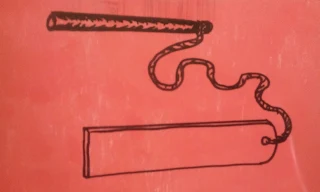
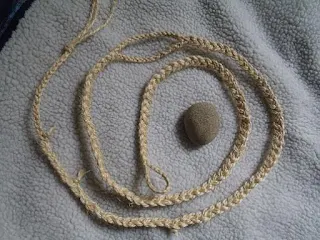
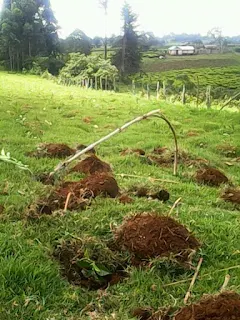







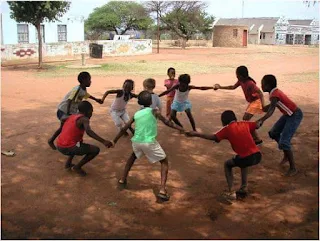








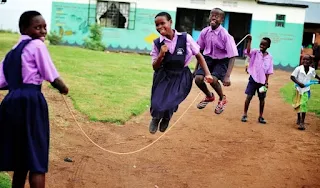



Comments
Post a Comment